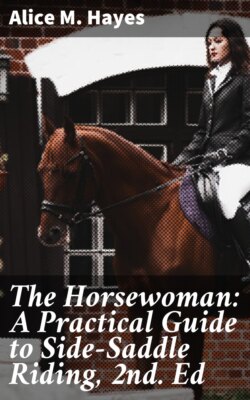Читать книгу The Horsewoman: A Practical Guide to Side-Saddle Riding, 2nd. Ed - Alice M. Hayes - Страница 16
На сайте Литреса книга снята с продажи.
SAFETY STIRRUPS,
ОглавлениеTable of Contents
both for men and ladies, have been in existence for hundreds of years. Apparently the first variety of this contrivance was the capped stirrup-iron, either simple (Fig. 18) or in the form of a slipper (Fig. 19), which was provided with an arrangement on its sole that prevented the toe of the slipper from yielding to downward pressure, but allowed it to revolve upwards, and thus to facilitate the release of the foot, in the event of a fall. The simple capped stirrup was used by ancient Spanish Cavaliers, and is still employed by many of their descendants in America. In apparent oblivion of these facts, the Christie stirrup (Fig. 20), made on the same principle, was patented about four years ago. Besides its undue weight (1 1/4 lb. as compared to the 1/2 lb. of the slipper stirrup), it has the further disadvantage of allowing the possibility of the toe being caught between its bars (Fig. 21). Want of neatness appears to have been the only cause of the abandonment of the capped stirrup, which is certainly safer than any of its successors, the first English one of which appears to have been the Latchford safety stirrup (Fig. 22). It consists of two irons; the small one, which is placed within the large one, being made to come out the moment the foot gets dragged in it, in which case it parts company with its fellow, and is then liable to get lost. The Scott safety stirrup (Figs. 23 and 24) has not this fault, for its inner iron always retains its connection with the outer one, and can be replaced without delay, if the lady after her tumble desires to remount. The Latchford, Scott ordinary, and Cope safety stirrup (Figs. 25 and 26) open only one way, so that the foot, when correctly placed in any of them, may not be liable, as in the event of a fall, to be forced through the outer iron, in which case the lady would almost to a certainty get hung up if her saddle was not provided with a safety bar. In these stirrups, the side of the “tread,”46-* which ought to be to the rear, is generally indicated by the fact of its being straight, while the other side is curved (Fig. 24). This is done in Fig. 27, by the word “heel.”
Fig. 18.—Capped stirrup-iron. Fig. 19.—Slipper stirrup.
Fig. 20.—The Christie stirrup.
Fig. 21.—Foot caught.
| Fig. 22.—Latchford stirrup. | Fig. 23.—Scott’s stirrup. |
Fig. 24.—Scott’s stirrup open.
The chief faults of so-called safety stirrups are as follows:—
1. They may catch on the foot, on account of getting crushed by coming in violent contact with a tree, wall or other hard object, or by the horse falling on his near side. When I was living in India, I had a Scott safety stirrup jammed on my foot in this manner, by a horse which I was riding, making a sudden shy and dashing against a wall. The iron was so firmly fixed to my foot by this accident, that it could not be taken off until, after much pain and trouble, my foot was freed from both boot and stirrup. Had I been unseated, I would probably have been killed, because my saddle had not a safety bar.
Fig. 25.—Cope’s stirrup.
2. Those which open only when the foot is put into them in one way, are apt to cause a fatal accident if put in the wrong way, which may easily happen from carelessness or ignorance (p. 64). The methods (straight edge of “tread,” or word “heel”) used with these stirrups, to indicate the proper side on which to put the foot into the iron, may convey no meaning to persons who are not well acquainted with the details of side-saddle gear, and in moments of hurry and excitement may be easily overlooked.
3. Any ordinary safety stirrup which is used without a safety bar may cause a lady to get “hung up,” if she is thrown to the off side and her heel gets jammed against the saddle in the manner shown in Fig. 28.
Fig. 26.—Foot released by Cope’s stirrup.
4. If the outer iron is small in comparison to the size of the foot, the rider may easily get dragged.
5. If the outer iron of a Scott’s reversible safety stirrup is large in comparison to the size of the foot (as in the case of a young girl), the rider may get dragged in the event of a fall, by the foot going through the stirrup. Accidents caused by a foot going through a stirrup have often occurred to men from falls when hunting and steeplechasing.
Fig. 27.—Scott’s stirrup.
Some ladies think it “smart” to ride with a man’s ordinary stirrup iron, or (madder still) with a small racing stirrup, attached to a leather which does not come out. I once saw a lady who adopted this senseless plan fall and get dragged. By an extraordinary piece of good luck she was saved from a horrible death by her boot coming off.
All that can be said in favour of safety stirrups, is that they are less liable to cause accidents than ordinary stirrups. The fact remains, that the danger of being dragged by the stirrup can be entirely obviated only by the use of an efficient safety bar.
Fig. 28.—Foot caught on off side.
